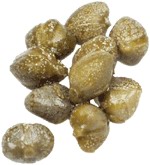Caper
 [ KAY-per ] The flower bud of a bush native to the Mediterranean and parts of Asia. The small buds are picked, sun-dried and then pickled in a vinegar BRINE. Capers range in size from the petite nonpareil variety from southern France (less than 1cm diameter, considered the finest), to those from Italy, which can be as large as the tip of your little finger. There are also the Spanish-imported stemmed caperberries that are about the size of a cocktail olive. Capers are generally packed in brine but can also be found salted and sold in bulk. Capers should be rinsed before using to remove excess salt.
[ KAY-per ] The flower bud of a bush native to the Mediterranean and parts of Asia. The small buds are picked, sun-dried and then pickled in a vinegar BRINE. Capers range in size from the petite nonpareil variety from southern France (less than 1cm diameter, considered the finest), to those from Italy, which can be as large as the tip of your little finger. There are also the Spanish-imported stemmed caperberries that are about the size of a cocktail olive. Capers are generally packed in brine but can also be found salted and sold in bulk. Capers should be rinsed before using to remove excess salt. The pungent flavor of capers lends piquancy to many sauces and condiments, pizza, fish, meats and salads; they're also used as a garnish for meat and vegetable dishes. The flavor of caper may be described as being similar to that of mustard and black pepper. In fact, the caper strong flavor comes from mustard oil: methyl isothiocyanate (released from glucocapparin molecules) arising from crushed plant tissues.
Medicinal Uses
Capers are said to reduce flatulence and to be anti-rheumatic in effect. In ayurvedeic medicine capers (Capers=Himsra) are recorded as hepatic stimulants and protectors, improving liver function. Capers have reported uses for arteriosclerosis, as diuretics, kidney disinfectants, vermifuges and tonics. Infusions and decoctions from caper root bark have been traditionally used for dropsy, anemia, arthritis and gout. Capers contain considerable amounts of the anti-oxidant bioflavinoid rutin.
Arabic ??? ????? Kabar
French C?pre, Fabagelle, Tapana
Hebrew צלף קוצני Tsalaf kotsani
Italian Cappero
Portuguese Alcaparras
Spanish Alcaparra, Caparra, T?pana; Alcaparr?n (caper berries)
*** The prefix al- in Iberic names (Portuguese alcaparra “caper”, Spanish alcaparr?n “caper berry”) indicates that these names are not simply inherited from Latin, but have been reloaned from Arabic al-kabara [?????] “the caper”, where the article al has been interpreted as part of the word and thus included into the loan word. In last consequence, Arabic kabara [???] is, of course, related to Latin capparis.





0 Comments:
Post a Comment
<< Home ::